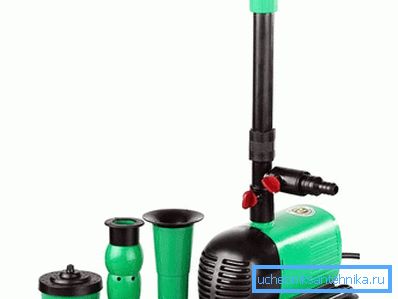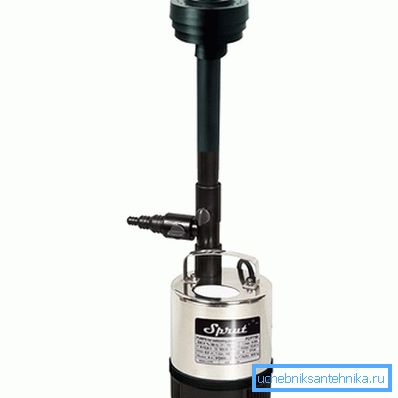Pump for the fountain itself
The fountain is a magnificent decorative element of an apartment, house or garden. On hot days, the fountain, besides beauty and attractiveness, will bring freshness and coolness, and the murmur of the room fountain will not only act soothingly, but also moisten the air in the room. In this article, you will learn how to install a fountain pump for yourself.
Types of pumps

The fountain consists of three main parts: a pump, a flow regulator and a nozzle. It is the nozzle that sets the shape of the fountain and the pattern of water movement; how well the pump is chosen depends on how well the fountain will function.
The feature of the pump for the fountain is that it must operate continuously, creating water circulation, so these pumps have a longer working life, but at the same time they are expensive, therefore other types of pumps are often used to reduce the cost of the process.
There are two types of pumps that are used to create fountains: submersible and surface. Submersible pumps are installed at the bottom of the fountain, and surface pumps on the shore in close proximity to the fountain. For normal operation of the fountain, it is necessary to select the pump parameters so that, with the required head and capacity, the pump works at medium engine speed.
If the pump is constantly running at too low or too high revs, it will overheat and shorten its life.

If we talk about the use of submersible pumps in the construction of a fountain on the site, then drainage or sewage pumps are well suited for this. They have great performance and can pump water that contains suspended matter and pollution. They are suitable for creating waterfalls, artificial streams and fountains.
When using a drainage pump for a fountain, it is necessary to install a filter, otherwise suspensions and impurities will clog the nozzle. You should not worry about this if your fountain is equipped with a simple high-capacity nozzle.
The submersible pump has a higher efficiency, so its operation is less energy consuming than the surface one. But these pumps have their drawbacks, in particular, they are not designed for long continuous operation and they need to be allowed to rest. There is also difficulty in maintaining them. The fact is that the pumps are installed at the bottom of the reservoir. For the winter period such unit needs to be dismantled.
Surface pumps for the installation of fountains are used less frequently and are used in complex structures, where a high jet or high pressure is required, or for multi-level waterfalls. Of the advantages of this type, it can be noted that there is no need to dismantle for the winter period and accessibility for maintenance.
Selection and installation

Before you make a fountain, you need to decide on its type, so that you can choose the right equipment, and organically fit the fountain into the landscape design.
The choice of pump performance is made on the basis of the height of the fountain jet or the height of the waterfall and the width of the stream bed. For a jet with a height of 1.2 m, a pump with a capacity of at least 0.8 m is needed3/ h, for a fountain height of 1.5 m, a pump with a higher capacity is needed - about 3 m3/ h If the waterfall is 50 mm wide, where water flows over a smooth surface, creating a thin curtain, then water consumption will be at least 450 l / h. To calculate the power of the pump, you first need to calculate what will be the flow of the fountain, and then select the pump based on the fact that its performance should be 50% more than the flow of the fountain or waterfall. In addition, it must be borne in mind that the performance of the pump decreases in proportion to the increase in pressure.
The installation of a submersible pump is carried out in the deepest place on a special pedestal of brick or concrete, which is installed at the bottom of the reservoir during the construction of the bowl until it is filled with water so that the pump does not draw silt from the bottom in the future.

To connect the submersible pump to the power supply network, it is necessary to use a double insulated cable, as well as a mandatory grounding.
Surface pumps are installed as close as possible to the fountain in the box to protect the device from precipitation, as well as for sound insulation, as they emit strong noise during operation.
On the supply pipe you need to install a valve to control and regulate the jet. If you install a tee on the supply pipe, the pump can be simultaneously used to create both a fountain and a waterfall.
At the end of the intake piping, it is necessary to install a strainer, and if the pump is located above the water level in the fountain, then a check valve is also installed.
For small fountains with a jet height of no more than 1.2 m or waterfalls up to 1 m high and a spillway width of several centimeters, a low-voltage pump (24 V) is suitable.
Video
The video describes in more detail the production of a fountain pump: